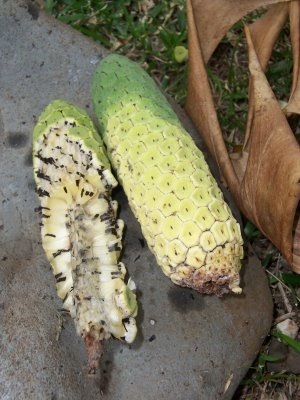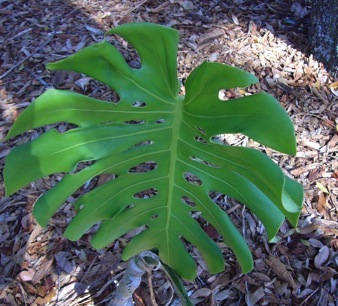Monstera deliciosa: Hmm Hmm Good!
Large Delight. That’s what Monstera deliciosa means…. It was an edible I did not know about until pointed out to me by my friend Maribou, who has experience in the ornamental trade. There is always something new to learn in the foraging world.
This is a tropical plant so you won’t find it in the wild much above Central Florida except in protected places. However it is one of the most common house and business plants in North America so keep your eye out for it. (Update three Years Later: Locally some excellent fruiting examples can be found climbing large oaks in Leu Gardens in Orlando. In fact, this past Jaunary [2011] they survived six nights of upper 20s F. and are fruiting!)
The Monstera deliciosa (mawn-STEER-ruh dee-liss-see-OH-suh) is one of several toxic arums that produce edibles. Just about every member of that family is laced with needle-shaped crystals of calcium oxalate called raphides. The crystals cause a burning sensation during consumption and can actually cause swelling of the throat leading to suffocation. If the crystals are swallowed they can also precipitate in the kidneys. Not good. Death from raphides is extremely rare if ever these days. Many members of the family can be made edible and some loose part of their toxicity upon ripening. Such is the case with the M. deliciosa and a few others.
Also called the “Windowleaf” the M. deliciosa a popular plant with large glossy leaves that have deep splits. They are also perforated with oblong holes and are often confused with some philodendrons. A liana, given a chance it will climb into the tops of high trees. It rarely branches and can reach more than 70 feet in length. Young leaves are heart shaped without holes. They cling close to a tree hence its other name “shingle plant.” Older leaves, with the slits and holes, also stand away from the tree.
Around age three the plant flowers. The inflorescent is a jack-in-the-pulpit like spadix and spathe, think a spike with a flowing cape around the back of it and above, or a spike with a shield behind and around part of it. It’s creamy and fleshy with tiny flowers. The cape is boat-shaped and surrounds the spike, which takes over a year to mature. It swells into an aromatic fruit (called Ceriman) that looks like a small green corn cob with hexagonal scales. When ripe its flavor is like a combination of banana and pineapple. Unripe it will burn your mouth intensely.
You can ripen the fruit off the plant if you collect it when the fruit’s first scales begin to lift up and the fruit is very pungent. Wrap in a paper bag and wait until the kernels begin coming off. You can then brushed the kernels off revealing the edible flesh underneath. The flesh is cut from the core like pineapple is and eaten. Try little first, a little fingernail-size piece. Chew it for a minute — a full minute even if it dissolves — then spit it out. Then wait 10 minutes. TEN full minutes, not nine. Ten. You want to make sure the raphides are gone. If they are in your mouth will have a burning sensation. (Relax, it will pass in an hour or so. Sucking on a lemon, or swishing with lemon juice will help.) Eating immature fruit which still has the kernels firmly attached will definitely get you a does of raphides. The seeds of the deliciosa are also edible when cooked or roasted.
Should you be in warm areas of the Americas the fruiting spike of the Chirrivaca (Monstera dilacerata mawn-STEER-ruh dee-lah-sear-AT-ta) is also edible (it looks like the M. delisiosa but does not have holes in its leaves.) The Monstera pertusa (mawn-STEER-ruh per-TOOS-ah) fruit spike is also edible and has numerous local names. The fruit spike of the Montrichardia arborescens (mon-trik-AR-dee-ah ab-or-ESS-ens) is edible as are its cooked or roasted seeds. An article in the Journal of Economic Botany says root is also eaten but I do not know how they prepare it to get rid of the raphides. Dry heat is usually the way. The M. arborescens has other uses as well. The fibers in the stem are used for cordage, the berries and fruiting spike used for fish bait, and the tissue in the stem can be used to make paper.
Green Deane’s “Itemized” Plant Profile
IDENTIFICATION: Huge, dark green, deeply-lobed, leathery leaves up to a yard long and wide, long stems, growing on a vine up to 70 feet long. Blossom is a large cream-colored spadix and spathe. Blooms around age three.
TIME OF YEAR: Usually blossoms in warm months
ENVIRONMENT: Grows in the shade, climbs trees.
METHOD OF PREPARATION: When fruit begins to lose scales, take off plant and ripen in paper bag. When you can brush the kernels off it is ready to eat but try a little first to make sure it is rid of raphides.




Ah, raphides…I experienced them when I tried a Jack-in-the-pulpit root when I was a kid. Not recommended. But Native Americans did get rid of them by long slow roasting; I understand it was still a famine food though.
In E. Turkey people use Arums as a pot herb. The leaves are loaded with calcium oxylate crystals. They chop the leaves, mix them with some flower and water to cover, seal the pot and let it sit a day to ferment. This is followed by long cooking. I’ve eaten it – you’d think there was lemon in the dish but the tartness comes entirely from the leaves. I have lots of it in the garden too but I haven’t had the guts to try and cook it myself, remembering my Jack-in-the-pulpit experience all too well!
I tried a monstera fruit recently. It certainly seemed ripe– the scales were falling off on their own or with a gentle tap. It tasted ripe or overripe (like very sweet pineapple juice beginning to ferment). But for some reason, it still made my mouth prickle! Wonder what was up with that.
They were not ripe enough, or, that particular species does not lose all of its pepperiness.
That’s a nice write up on the plant.